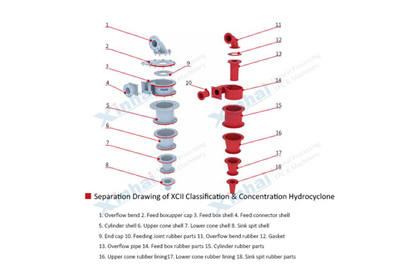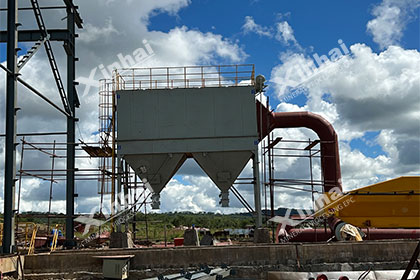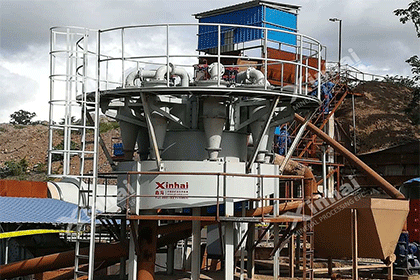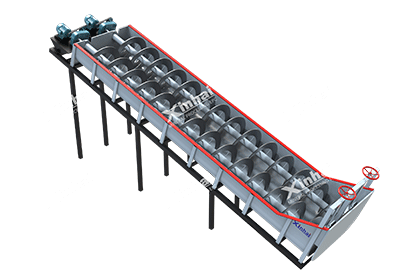7 Influences Of Hydrocyclone Structure On Classification Effect
 Star
Star
 Nov 13, 2020
Nov 13, 2020
 2233
2233
If you want to know more details about equipment, solutions, etc, please click the button below for free consultation, or leave your requirements!
.jpg)
Hydrocyclone is a kind of high-efficiency grading and desliming equipment. Because of its simple structure, large processing capacity and small footprint, it is widely used in various industries.
The following picture is a structural diagram of a hydrocyclone. Its structural parameters include the diameter of the cyclone, feed port, overflow port, and underflow port, the insertion depth of the overflow pipe, the length of the hydrocyclone column and the cone angle of the cyclone.
This article will introduce in detail the influence of these 7 cyclone parameters on the classification effect.

011. Hydrocyclone Diameter
BackThe diameter of the hydrocyclone mainly affects its processing capacity and separation particle size. Generally speaking, as the diameter of the cyclone increases, its processing capacity and separation particle size will increase.
For projects with coarse overflow and high processing capacity requirements, large-diameter hydrocyclones are generally used.
When separating materials with very fine particle size, a small diameter hydrocyclone should be used.
Compared with small-diameter hydrocyclones, large-diameter hydrocyclones are easy to use and not easily blocked. Therefore, when the same performance index can be obtained, a large-diameter hydrocyclone should be used first.
022. Diameter of the Feed Port of the Hydrocyclone
BackThe inlet of the cyclone is divided into double inlet and single inlet, double inlet is for large processing volume, and single inlet is for small processing volume. The influence of the feed port diameter on the separation efficiency is more complicated.
Under a certain feed flow rate, the smaller the feed inlet diameter, the higher the inlet velocity, the greater the centrifugal force, and the higher the separation efficiency.
However, if the diameter of the inlet is small, the inlet velocity will be large.
When the inlet velocity is large to a certain extent, strong turbulence will be generated at the inlet and the swirling cavity. The resulting strong shearing force will seriously damage the integrity of the material and make the material particle size reduce, thereby reducing the separation efficiency.
Therefore, it is very important to select an appropriate feed port diameter. Usually the inlet diameter of the liquid-liquid hydrocyclone is 0.15-0.25 of the diameter of the cyclone.
033. Diameter of the Overflow of the Hydrocyclone
BackThe diameter of the overflow is an important factor affecting the separation performance of the hydrocyclone. It not only affects the split ratio (the ratio of underflow volume flow to overflow volume flow), but also affects the inlet feed volume and the energy loss of the overflow.
Generally, the larger the diameter of the overflow pipe, the larger the inlet feed volume and the larger the cyclone split ratio. When the inlet pressure is constant, increasing the overflow diameter within a certain range will increase the production capacity and the separation particle size.
The diameter of the overflow port should be slightly larger than the diameter of the feed port, generally 0.2-0.3 of the diameter of the cyclone.
044. Diameter of the Bottom Orifice of the Hydrocyclone
BackThe diameter of the underflow port has a significant effect on the processing capacity and split ratio of the hydrocyclone.
As the diameter of the underflow port increases, the processing capacity of the hydrocyclone increases, and the split ratio increases accordingly;
As the diameter of the underflow port decreases, the underflow concentration will increase to a certain limit, and the separation particle size will increase, but the overall separation efficiency will decrease.
Usually the best underflow port diameter is 0.07-0.1 times the diameter of the cyclone.
055. Insertion Depth of Overflow Pipe
BackThe depth of the overflow pipe extending into the cyclone should be lower than the plane of the inlet. As for the optimal depth, it must be determined through experiments.
If the overflow pipe is higher than the feeding plane, it will cause a short circuit when the working conditions change.
If the overflow pipe is inserted too deep, a large area of turbulence will be formed near it, which will affect the distribution of the equal density surface.
Usually, the optimal insertion depth of the overflow pipe is 0.33-0.5 times that of the cyclone.
066. Length of Column Section of Cyclone Cylinder
BackThe cylindrical column section of the hydrocyclone mainly contains, stabilizes and buffers the inlet liquid flow. At the same time, it can also pre-swirl the liquid flow and stabilize the overflow. The length of the hydrocyclone has little effect on the separation efficiency.
If the column section of the cylinder is too short, the separated coarse material will be concentrated in the cone section, which increases the possibility of re-mixing.
If the length of the cylindrical column section is too long, the axial size of the cyclone will be enlarged, which will increase the energy consumption of the liquid and affect the separation efficiency in the cone section.
Usually the length of the cylindrical column is 0.7-2 times the diameter of the cyclone. The length of the cylindrical column section of the hydrocyclone for solid-liquid separation should be appropriately selected to a larger value.
077. Cone Angle of Hydrocyclone
BackAccording to the angle of the cone, hydrocyclones are divided into long cone type (angle ≤10°), standard type (angle 15°-20°) and short cone type (angle>20°).
The fluid resistance in the hydrocyclone increases with the increase of the cone angle, and the separation particle size also increases with the increase of the cone angle. At the same time, the small cone angle helps the sediment on the wall to enter the discharge port along the wall. Therefore, the cone angle is better.
However, if the cone angle is too small, it is easy to cause blockage and wear of the underflow port.
Therefore, it is recommended to use a small cone angle for the hydrocyclone for solid-liquid separation, but if the slurry concentration is large and the particles are coarse, a large cone angle (>40°) should be considered to prevent the underflow port from clogging.
08To Wrap Up
BackThe above 7 influences of hydrocyclone structure on classification effect. In addition, the separation efficiency of the cyclone is also closely related to fluid physical properties, such as viscosity, concentration, and temperature. Therefore, when choosing a cyclone model, many factors must be considered.
If you have different opinions on the above content, or want us to help you choose the right cyclone, you can contact the online customer service of the website or leave a message, we will contact you ASAP!
 +86 182 3440 3483
+86 182 3440 3483 yanzhang19990421@gmail.com
yanzhang19990421@gmail.com




 Message
Message Chat Now
Chat Now

















